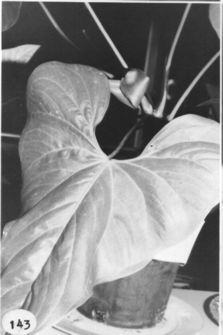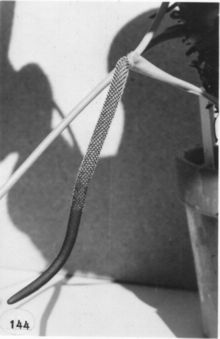





Anthurium rotundistigmatum Croat,
Selbyana 5: 330. 1981. TYPE: Panama. Darien: Serrania de Pirre, along ascent above Cana gold mine between Río Cana and Río Escucha Ruido, 600-1,000 m, premontane rain forest (Holdridge Life Zone Map), Croat 37745 (MO 2465320, holotype; F, K, NY, PMA, US, VEN, isotypes; Live at MO).
Epiphyte; stems 15-30 cm long, 1.5-2.5 cm diam.; leaf scars 1.4-2 cm wide, roots few, 2-3 mm diam.; cataphylls coriaceous, (5-)9.5-10 cm long, acute and apiculate at apex (the apiculum ca. 2 mm long), green or suffused with violet purple, turning brown on drying (B & K Red 9/10), deciduous more or less intact.
LEAVES with petioles erect or spreading, (22-)28-40 cm long, 4-6 mm diam., sometimes tinged purplish near base, shallowly and bluntly sulcate, rounded abaxially; geniculum 2-4 cm long, same color and shape as petiole; blades ovate-triangular, acuminate and downtuned at apex, deeply lobed at base, (23-)26-56 cm long, 17-30 cm wide, broadest at point of petiole attachment, the anterior lobe 19-45 cm long, the posterior lobes 7-18 cm long, the sinus parabolic, sometimes spathulate, rounded or obtuse at apex; upper surface matte to semiglossy, lower surface matte; midrib prominently and convexly raised below; basal veins 5-7 pairs, up to 5 of them coalesced 2.5-3 cm, paler than surface and sunken or raised in valleys above, the posterior rib naked ca. half way, the outer margin rolled inward except near the point of petiole attachment; primary lateral veins 4-8 per side, departing midrib at 40�45° angle, paler than surface, sunken above, raised and paler than surface below, arcuate ascending; interprimary veins flat or sunken and paler above, raised and darker below; collective vein arising from near apex, 2-6 mm from margin, sunken above, raised below.
INFLORESCENCE spreading; peduncle 8-13.5 cm long, 3-7 mm diam., flexible to more or less stiff, shorter than petiole; spathe subcoriaceous, pale green heavily tinged with reddish purple at anthesis, usually drying reddish brown, oblong-oblanceolate, 8-12.5 cm long, 1-3.8 cm wide, broadest ca. 2 mm above the point of attachment, acuminate at apex, rounded at base, inserted at ca. 45° angle on peduncle, spreading and often twisted, the margins upturned, forming a pocket at the base; spadix purplish (B & K Purple 2/2.5) at anthesis, 10-17 cm long, 7-11 mm diam. at base, 4-5 mm diam. At apex; flowers 4-lobed, 3-3.5 mm long, 2-2.5 mm wide, the sides jaggedly sigmoid, 9-12 flowers visible in the principal spiral, 7-8 flowers visible in the alternate spiral; tepals dark purple with pale punctuation's, minutely papillate, semiglossy, separating as stamens emerge to show deep, pale yellow cracks, the lateral tepals 1.6-1.8 mm wide, the outer margin irregularly 3-sided; pistil slightly emergent at anthesis, paler than tepals (translucent white suffused with purple), at first covered by tepals, exposed ca. 1 week before first stamens emerge, becoming prominently exserted; stigma oblong-elliptic, white, ca. 0.5 mm long with glistening papillae, filled with droplets 4-6 days before stamens emerge, dry when stamens open; stamens usually emerging from the base or sometimes scattered throughout, developing a full complement promptly except for the flowers in the advancing spirals, the stamens positioned at random around pistil; filaments retracting to hold anthers against pistil, transparent, ca. 0.7 mm long, 0.6 mm wide; anthers yellow, held curved over pistil before opening, ca. 0.9 mm long, 0.7-0.8 mm wide; thecae ellipsoid, not divaricate; pollen yellow fading white (B & K Yellow 9/7.5).
INFRUCTESCENCE pendent, to 25 cm long, 4 cm diam. with berries exserted; berries obovoid, rounded at apex, ca. 6 mm long, 4.5 mm diam., red at apex, the exposed area around the style round and scurfy, ca. 2 mm diam.; pericarp thin, with moderately few punctiform raphide cells near the apex; seeds 2, broadly ellipsoid, markedly flattened, greenish, 2.5-3 mm long, 2.2-2.5 mm wide. Figs. 143 and 144.
The species is known for certain from tropical wet and premontane wet forest at elevations of 500 to 1,000 m in Darien Province. Sterile collections from Cerro Jefe [Croat 35924 MO) and Cerro Tute (Croat & Folsom 34233 MO) are probably also this species. Another sterile collection (Croat 34440 MO) from tropical moist forest at less than 150 m also matches this species but is well outside the expected ecological range of the species. The species is a member of section Belolonchium and is best characterized by its thin, ovate-triangular leaves, its purplish spadix, and especially the markedly protruding, round (hence the name rotundistigmatum) stigmas that emerge from the tepals well before the stamens emerge. Though sterile collections of Anthurium rotundistigmatum can be confused with A. ochranthum, the latter species is consistently terrestrial and has a bright yellow spadix at maturity with pollen usually oozing from submerged anthers in slender paste-like ribbons.
 |
 |
Map of Mesoamerican specimens with coordinates
Panama Darien: Rancho Frio, 600 m, 7.58N 77.42W, 9 Aug 1986, McDonagh
et al. 567 (BM).
Panama Darien: 550-760 m, 7.57N 77.46W, 28 June 1988, Thomas B. Croat
68867 (MO).
Panama Darien: 550-760 m, 7.57N 77.46W, 28 June 1988, Thomas B. Croat
68889 (MO).
Panama Darien: 550-760 m, 7.57N 77.46W, 28 June 1988, Thomas B. Croat
68899 (MO).
Panama Darien: 900-1250 m, 07.45N 77.40W, 26 August 1987, Gordon McPherson
11608 (MO).
Panama Darien: 600-850 m, 08.03.30N 77.17.00W, 15 octubre 1987, Hermes
Cuadros V., B. Hammel, G. deNevers y H. Herrera 3860 (MO).
Panama Darien: Parque Nacional del Darién, 450-600 m, 8.03N
77.20W, 14 Oct. 1987, Greg de Nevers, H. Cuadros, B. Hammel & H. Herrera
8330 (MO).
Panama Darien: 600-800 m, 8.05N 77.16W, 24 Oct 1987, B. Hammel G. de
Nevers, H. Cuadros & H. Herrera 16476 (MO).
Panama Darien: 08.30S 077.30W, 27 July 1976, Thomas B. Croat 37745
(B,GH,F,K,MEXU,MO,NY,PMA,QCA,RSA,US,VEN,WU).
South American Specimens with coordinates
Colombia Antioquia: Las Orquideas, 950-1060 m, 6.33N 76.19W, 6 June
1988, A. Cogollo et al. 3279 (MO).
Colombia Antioquia: Las Orquideas, 1095 m, 6.34N 76.19W, 23 July 1988,
A. Cogollo et al. 3418 (MO).
Colombia Antioquia: (Filed with Cardiolonchium indets), 1850 m,, 3
Mar. 1988, Escobar, L.A. et al. 8201 (HUA).
Colombia Antioquia:, 22 Oct. 1987, Escobar et al. 7994 (HUA).
Colombia Antioquia: 1850 m,, 3 Mar. 1988, Escobar et al. 8205 (HUA).
Colombia Antioquia: 1850 m,, 20 Nov. 1986, Escobar et al. 7292 (HUA).